|
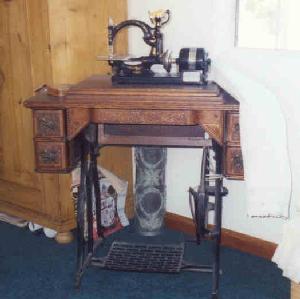 The first several years the sewing machine was
available in America are curious ones to reflect upon . . . one would think
women had flocked to buy them, assuming they could afford them, as they were not
cheap, but they did not. In fact, when mechanic,
Elias
Howe Jr., patented
his invention in 1846 (it featured a horizontal needle; and the lock stitch,
invented by Walter Hunt in the 1830s), he could hardly get anyone to notice. The
Patent Museum shows a copy of the original application and drawing. The first several years the sewing machine was
available in America are curious ones to reflect upon . . . one would think
women had flocked to buy them, assuming they could afford them, as they were not
cheap, but they did not. In fact, when mechanic,
Elias
Howe Jr., patented
his invention in 1846 (it featured a horizontal needle; and the lock stitch,
invented by Walter Hunt in the 1830s), he could hardly get anyone to notice. The
Patent Museum shows a copy of the original application and drawing.
But, it
was the marketing genius of Isaac Singer that put them into the hands of women
across America. He introduced his version of the lock stitch machine (with a
vertical needle and foot treadle) in 18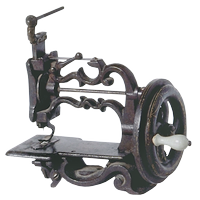 51 and patented it in 1856. See one of
his 1853 commercial
machines. 51 and patented it in 1856. See one of
his 1853 commercial
machines.
Singer was charming, outgoing, and quite the ladies' man. He would travel to
different towns to set up rooms filled with sewing machines. He offered all the
women the opportunity to sew, at their leisure.
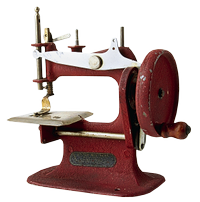 When they were impressed, he
offered to let them take the machine home right then, for a small down payment
and a contract to pay it off over time. He was the grandfather of the credit
card, you might say. By the mid-1860s, the sewing machine was in common use, and
within the next couple of decades, was in most homes. The 'chain stitch'
appeared in 1851, and the 'zig zag stitch' in the 1870s. When they were impressed, he
offered to let them take the machine home right then, for a small down payment
and a contract to pay it off over time. He was the grandfather of the credit
card, you might say. By the mid-1860s, the sewing machine was in common use, and
within the next couple of decades, was in most homes. The 'chain stitch'
appeared in 1851, and the 'zig zag stitch' in the 1870s.
One historian estimates that between 1865 and 1900, approximately 10% of
quilts had some form of machine work on them. I have studied many quilts made
during this time, and seldom have I seen machine quilting. When I have, it is
more likely from the 1880s or 1890s. Machine piecing is more common.
The Amish used their treadle machines to piece their quilts, a fact
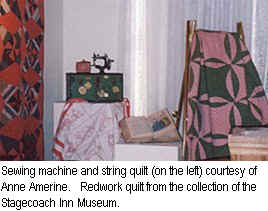 that many
people do not
realize, because of the Amish beautiful and skillful hand quilting. However, the
Amish made their quilts to serve a purpose, and the sewing machine made it
faster to accomplish that end. You will also find women often used their machine
to put on the binding, even when the quilt was hand-made. It is believed they
did this to show off their machine!
that many
people do not
realize, because of the Amish beautiful and skillful hand quilting. However, the
Amish made their quilts to serve a purpose, and the sewing machine made it
faster to accomplish that end. You will also find women often used their machine
to put on the binding, even when the quilt was hand-made. It is believed they
did this to show off their machine!
Besides the cost, I believe the reason the sewing machine was not immediately
embraced is because women took great pride in their ability to make all the
clothes, bedding, and household decor for their families, and it was one of the major
ways they contributed to their family’s needs. As much as it was grueling work
at times, and seemingly never-ending, to take it away by speeding it up and
making it so simple would be to take away a big part of their way of nurturing
and raison d’etre within the family. I call it the, “Betty
Crocker Instant Cake Mix Syndrome.” Advertising history tells us that women in
the war years had a similar response to this new quick cake mix, when it was
first introduced. It failed so miserably, they took it off the shelf.
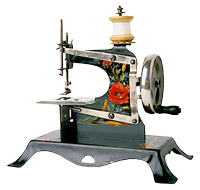
Here's another point of view on the newly invented sewing machine - This conversation may be referring to factory machines, since it says
the machine makes 400 stitches a minute!
In an article from 1873, in Arthur's Illustrated Home Magazine, #6,
there was a letter written to a friend, written 25 years earlier [1848] about
the virtues of the sewing machine.
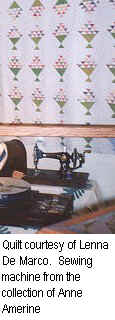 "I have been examining a new machine for sewing, which has recently
been invented and constructed by an ingenious mechanic of Cambridge.....this is
the first attempt to construct a machine of this kind, and it appears to be
successful......it is very correct and does not occupy a space of more than
about six inches either way. It runs with such ease that I should suppose one
might easily operate twenty or thirty of them, and the work is done in a most
thorough and perfect manner.
"Both sides of the seam look alike, appearing to be beautifully stitched,
and the seam is closer and more uniform than when sewn by hand. It will sew
straight or curved seams with equal facility and so rapidly that it takes
but two minutes to sew the whole length of the outside seam of a pair of
men's pantaloons. It sets 400 stitches a minute.
"The thread is less worn by this process than by hand-sewing and
consequently retains more of its strength. The simplicity of this machine, and
the accuracy, rapidity and perfection of its operation, will place it in the
same rank with the card-machine, the straw-binder, the pin-machine, and the
coach-lace loom, machines which never fail to command the admiration of every
intelligent beholder."
Views have changed significantly since the sewing machine as we know it, came
on the scene. Or have they? Contrast this with the ongoing discussion today
about the virtues of hand quilting over machine quilting, and custom machine
quilting over a longarm quilting machine.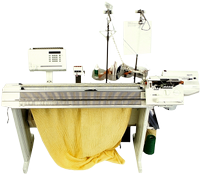
It seems the machine age is still vying for equal status. I'm surprised there
hasn't been more discussion given to the use of computer machine fancy stitches
vs. hand embroidery. Maybe that will change, now that the crazy quilt is getting
more attention and more reproductions are being made.
My feeling is . . . let the craft, the art, and the creativity flow in
whatever way it possibly can. Set no limits, and you can see where the creative
mind and hand can take us. Each individual can choose that which they desire to
produce, buy, or see. With limits set and negative judgments left to stand as
truth, the process stops unfolding.
Also see Anne Johnson's article The
True History of the Sewing Machine: ~ Isaac Singer, scoundrel or genius ~
Thank you Joan Kiplinger for making the Arthur's
Illustrated Home Magazine #6 information available. See Vintage Fabric: In Search Of Warp Ends
to learn more about Joan and her contributions on vintage textile and sewing
history.
If you skipped the article on Elias Howe, take a
minute; his story is fascinating.
"The
Real Story Behind 'Thread City'" Windham, Connecticut by Kimberly
Wulfert, PhD - A destination on my A Quilter's Journey through New England
Tour, is the old Willimantic Linen Company in Willimantic, CT. This small,
but wonderful, museum is housed in an old boarding house where the workers once
lived.
Teachers contact me for written permission.
For more sewing machine history, see
Anne Kusilek's
article:
The
Non-Electric Sewing Machine,
People Powered Sewing Machines, Not Just for the
Amish
|